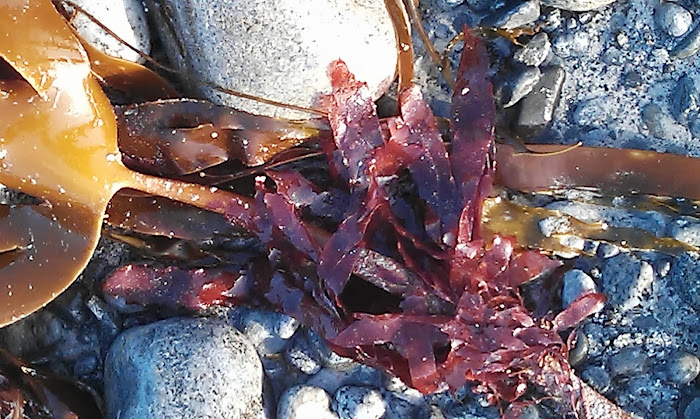As autumn creeps upon us, the Island nights are drawing in. Soon the
cows and sheep will return to the machair (fertile land by the sea) and so,
local crofters are lifting their crops before the animal are put back to graze.
Of late, an occasional bag of root vegetables and onions, well coated in
machair sand has been left at the back door. The earthy offering is silently
given and left without a calling card. Harvest gifts bring warmth and comfort
as we stock up for winter and for the forager, the leaner months of the year. For the seaweed harvester
however, many species continue to grow through out the year. The invasive
wireweed, Sargassum muticum will disappear but many of my stalwart
kitchen favourites can be gathered over the colder months. Pepper dulse is said
to be less pungent but my autumn gatherings still add spice to casseroles and
fire to syrups. Dried or fresh seaweed cooked with potato is a poverty food
marriage that has worked for coastal generations. It may be associated with
famine and hardship but it is an essential recipe in my Island cook's
repertoire.
Chopped
dulse added to boiling, diced potatoes will cook in much the same time and
there's magic in the pot, as the ruby-red dulse changes colour from red to
green. Drain the dulse and potatoes well, and then add lashings of butter and
milk as you mash the sea and root vegetable together. A wow umami - think
vegetarian smoky bacon mingled with the reassuring comfort of childhood mashed
potato. When dried bladder wrack is scattered over par-boiled potatoes, which
are ready for roasting, the result is a golden, nutty crunch without the salt.
Traditional Irish champ also benefits from the addition of finely chopped dillisk
(dulse) as does English bubble and squeak or Scottish stovies. Laver (think
nori) can be gathered from rocks at low tide throughout the UK. When
well-washed and cooked (laverbread) and then mashed with potatoes, it make an
excellent fishcake base. In Wales, where laver is often referred to as black
caviar, the combination is used in the traditional dish Gratin Tatws a
Bara Lawr.For the seaweed harvester however, many species continue to grow
through out the year.The invasive wireweed, Sargassum muticum will
disappear but many of my stalwart kitchen favourites can be gathered over the
colder months. Pepper dulse is said to be less pungent but my autumn gatherings
still add spice to casseroles and fire to syrups. Dried or fresh seaweed cooked
with potato is a poverty food marriage that has worked for coastal generations.
It may be associated with famine and hardship but it is an essential recipe in
my Island cook's repertoire.
Chopped
dulse added to boiling, diced potatoes will cook in much the same time and
there's magic in the pot, as the ruby-red dulse changes colour from red to
green. Drain the dulse and potatoes well, and then add lashings of butter and
milk as you mash the sea and root vegetable together. A wow umami - think
vegetarian smoky bacon mingled with the reassuring comfort of childhood mashed
potato. When dried bladder wrack is scattered over par-boiled potatoes, which
are ready for roasting, the result is a golden, nutty crunch without the salt.
Traditional Irish champ also benefits from the addition of finely chopped
dillisk (dulse) as does English bubble and squeak or Scottish stovies. Laver
(think nori) can be gathered from rocks at low tide throughout the UK. When
well-washed and cooked (laverbread) and then mashed with potatoes, it make an
excellent fishcake base. In Wales, where laver is often referred to as black
caviar, the combination is used in the traditional dish Gratin Tatws a
Bara Lawr.
Sea Lettuce Gnocchi
This
is one of my favourite comfort foods. I often make it with machair potatoes,
which crofters fertilise with organic tangle (seaweed) collected from the
nearby beach. It's real local food and seaweed is central to the growing as
well as the cooking of the potatoes. Seaweed is good gardening as well as
cooking news. Gnocchi may also be made using leftover potato.
Serves
4
What
to find:
Marine
algae: 3-4 lengths of sugar kelp (and one for cooking the gnocchi) 4tsps dried
sea lettuce (to taste)
700g
Floury potatoes
150g
plain flour
Large
Egg yolk
Pre
heat the oven 180ºC gas 4
Line
a baking tray with sugar kelp. Wash and dry the potatoes and fork the skins and
then put them on top of the seaweed.
Put
the tray into a preheated oven and bake for about 1.5 hours or until the
potatoes are soft (depending on the size of the potato). Remove from the oven
and when the potatoes are cool enough to handle, peel off the skin and put the
potato into a bowl. Feed the cooked potato through a ricer or sieve into a
second bowl and add the flour, egg yolk and 3 tsps of sea lettuce. Season with
black pepper and roll the potato into 2 long sausage shapes. Cut 2-3cm lengths
and mark the gnocchi characteristically with a fork.
Bring
a pan of water to the boil with a small length of sugar kelp and cook the
gnocchi in batches (do not over crowd the pan). The gnocchi are cooked when
they float to the surface (about 2 minutes). Remove the cooked gnocchi with a
slotted spoon.
Transfer
the gnocchi to a warm bowl and drizzle with olive oil and the remaining tsp of
ground sea lettuce.




